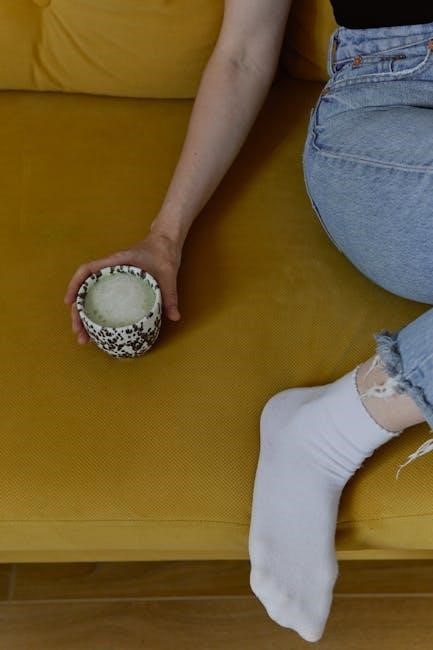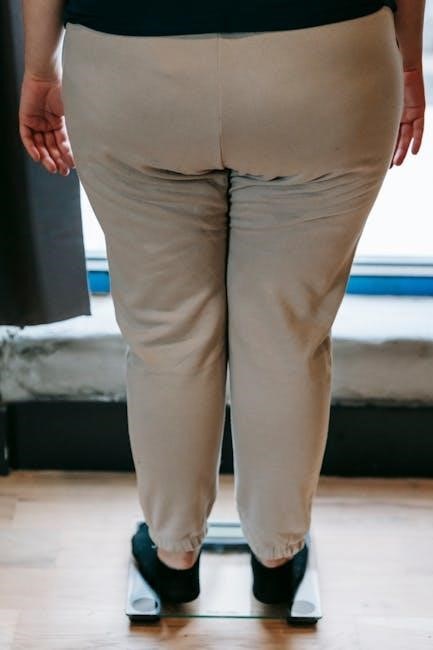Discover the importance of proper sock fit and how to choose the right size for comfort and performance. This guide provides comprehensive charts, measurement tips, and style advice to ensure optimal fit for all activities and preferences.
Importance of Proper Sock Fit
Proper sock fit is essential for comfort, performance, and foot health. Ill-fitting socks can cause discomfort, blisters, or restricted movement, while well-fitting ones provide support and prevent issues like calluses or fungal infections. Socks that are too tight may impede circulation, while those too loose can bunch up and cause irritation. The right fit ensures optimal cushioning, moisture-wicking, and breathability, tailored to specific activities or needs. Prioritizing proper sock fit enhances overall comfort and promotes healthy feet for everyday wear or athletic pursuits.
Understanding Sock Size Charts
Sock size charts are tools that help match foot measurements to ideal sock sizes. They typically correlate foot length in inches or centimeters with corresponding sock sizes, ensuring a comfortable fit. Charts may vary by brand, style, or region, so it’s crucial to refer to specific guides for accuracy. Most charts list ranges, accommodating variations in foot shape and personal preference. By understanding how these charts work, you can make informed choices, avoiding common issues like tight or loose socks, and enjoy a seamless fit tailored to your needs.
How Sock Sizing Works
Sock sizing is based on foot length, measured in inches or centimeters, and categorized into standard sizes. Sizes often represent a range, such as 9-11, to accommodate different foot shapes and preferences. The fit is influenced by material thickness, stretch, and sock style, like ankle or crew. While shoe size is a starting point, direct foot measurement ensures accuracy. Brands may adjust sizing, so consulting specific charts is essential for the best fit. This system ensures comfort and performance across various activities and lifestyles, making it versatile for all users.

How to Measure Your Foot for Sock Size
Measure your foot length by tracing it on paper or using a ruler. Ensure accuracy by measuring the longest part and considering foot circumference for the best fit.
Tools Needed for Accurate Measurement
To measure your foot accurately, you’ll need a few simple tools. Start with a flat piece of paper large enough to fit your foot and a pencil to trace its outline. A ruler or measuring tape is essential for determining length and circumference. For added precision, use a flexible measuring tape to wrap around the widest part of your foot. Ensure you’re standing or sitting comfortably to get an accurate measurement. These tools will help you determine your sock size effectively and ensure a comfortable fit.
Step-by-Step Guide to Measuring Foot Length
Start by placing your foot on a flat piece of paper, ensuring it’s aligned straight. Trace the outline of your foot with a pencil, capturing the longest point from heel to toe. Use a ruler or measuring tape to measure this length in inches or centimeters. Record the measurement accurately, as this will determine your sock size. For the most precise fit, measure both feet and use the larger size. This step ensures you select socks that align perfectly with your foot length, providing comfort and preventing blisters or tightness.
Understanding Foot Circumference and Its Impact on Sock Fit
Foot circumference plays a crucial role in ensuring a comfortable and proper sock fit. While foot length is commonly used to determine sock size, circumference often goes unmeasured, leading to potential discomfort or ill-fitting socks. To measure circumference, wrap a flexible measuring tape around the widest part of your foot, just above the arch. This measurement helps determine if you need slim, regular, or wide socks. Brands often use stretchy materials to accommodate variations, but precise measurement ensures optimal comfort and support. Consider both length and circumference for the best fit.

Comprehensive Sock Size Chart
Find your perfect fit with our detailed chart, covering adult and kids’ sizes, shoe size correlations, and international size conversions for seamless sock selection.
Adult Sock Size Chart
Adult sock sizes are typically determined by shoe size, with men’s sizes ranging from 6-12.5 and women’s from 4-10.5 in U.S. sizing. Sock sizes are often labeled as ranges, such as 9-11 or 10-13, which correspond to foot length in inches. For accurate fit, measure your foot length and match it to the chart. International sizes vary, so refer to U.S. to EU or UK conversion guides. Proper fit ensures comfort and prevents blisters or tightness. Use a sizing chart for precise selection, as sock stretchiness allows for flexibility in fit.
Men’s Sock Sizes
Men’s sock sizes typically range from 6 to 12.5 in U.S. shoe sizes, with socks labeled as size ranges like 9-11 or 10-13, reflecting foot length in inches. These ranges accommodate varying foot lengths and ensure a comfortable fit. Socks are stretchy, allowing flexibility, but proper measurement is key for optimal comfort. Use a sock size chart to match your shoe size with the appropriate sock size. International conversions are also available for EU and UK sizes, ensuring accurate fit regardless of region. Always consider activity and sock thickness when selecting sizes for the best fit.
Women’s Sock Sizes
Women’s sock sizes generally range from 4 to 10.5 in U.S. shoe sizes, with sizes labeled as 9-11 or 10-13, indicating foot length in inches. These ranges are designed to fit various foot lengths comfortably. Socks are stretchy, but accurate measurement is essential for the best fit. Use a sock size chart to match your shoe size with the correct sock size. International conversions are available for EU and UK sizes, ensuring accurate fit globally. Consider activity and sock thickness when selecting sizes to ensure comfort and performance.
Kids’ Sock Size Chart
Kids’ sock sizing can be challenging due to rapid growth and varying foot lengths. Sizes often correlate with age ranges but focus on precise foot measurements. A child’s sock size typically ranges from 4-7 for toddlers and up to 13 for older kids. Charts may list sizes by foot length in inches or centimeters. Parents should measure their child’s foot regularly and refer to specific brand charts for accurate fit. Stretchy materials help accommodate growth, but proper measurement ensures comfort and avoids ill-fitting socks.
Understanding Sock Length and Style
Socks come in various lengths and styles, such as ankle, quarter, crew, and over-the-calf. Each style offers unique benefits for comfort, support, and aesthetic appeal in different activities.
Ankle Socks
Ankle socks are a popular choice, offering a low-profile design that sits just above the ankle. They are ideal for casual wear, athletic activities, and warm weather. Typically fitting shoe sizes 4-7.5 for women and 5-8 for men, they provide a snug, breathable fit. Ankle socks are versatile, suitable for sneakers, sandals, and even dress shoes. Their short length reduces bulk, making them perfect for lightweight comfort. Whether for sports or everyday use, ankle socks are a practical and stylish option for various occasions.
Quarter Socks
Quarter socks, also known as “mini-crew” socks, offer a mid-calf length, providing more coverage than ankle socks but less than crew socks. They are versatile and suitable for both casual and athletic wear. Typically fitting shoe sizes 4-7.5 for women and 5-8 for men, quarter socks are ideal for activities like running or hiking, offering support without feeling bulky. Their length makes them a great choice for seasonal transitions, balancing comfort and style for various occasions.
Crew Socks
Crew socks are a popular mid-calf length style, typically reaching between 6-8 inches above the heel. They are versatile and suitable for casual, athletic, or dress wear. Crew socks usually fit shoe sizes 4-7.5 for women and 5-8 for men, offering a snug yet comfortable fit. Made from stretchy materials, they accommodate various foot shapes and activities. Ideal for sports, they provide arch support and cushioning. Crew socks are also a practical choice for colder weather, offering thermal insulation without being too bulky.
Over-the-Calf Socks
Over-the-calf socks extend above the calf, typically reaching 8-11 inches above the heel. They are ideal for formal or business attire and provide excellent support and warmth. These socks usually fit shoe sizes 6-12 for men and 5-10 for women. Over-the-calf styles often feature compression for improved blood flow and are made from stretchy materials for a snug, comfortable fit. They are popular for their ability to stay in place throughout the day without slipping down, making them a practical choice for both style and functionality.

Material and Thickness Impact on Sock Size
Material and thickness significantly affect sock fit. Thicker socks may require a larger size, while thinner styles fit snugly. Choose based on activity and comfort needs.
Thin Socks
Thin socks are lightweight and breathable, offering a snug fit without bulk. Ideal for warm weather, casual wear, or tight-fitting shoes, they provide comfort and moisture-wicking properties. Suitable for activities like running or yoga, thin socks often feature seamless construction for reduced friction. They are stretchy and can accommodate a range of foot sizes, making them versatile for everyday use. Choose thin socks for a sleek, barely-there feel that enhances movement and keeps feet cool during active endeavors.
Medium-Weight Socks
Medium-weight socks strike a balance between comfort and durability, making them ideal for everyday wear. They offer more cushioning than thin socks while maintaining breathability, ensuring moisture-wicking properties. These socks are versatile, suitable for casual outings, work, or light outdoor activities. Crafted from materials like cotton blends or wool, they provide softness and support without feeling bulky. Medium-weight socks are perfect for moderating foot temperature, keeping feet warm in cooler weather and cool in warmer conditions. Their balanced design makes them a practical choice for various occasions.
Thick Socks
Thick socks are designed for cold weather and high-impact activities, offering superior warmth and cushioning; Made from materials like wool or fleece, they provide excellent insulation and durability. These socks are ideal for outdoor adventures, hiking, or layering during winter. While they may feel bulkier, their dense weave ensures moisture-wicking properties and long-lasting comfort. Thick socks are perfect for boots or heavy footwear, offering extra support and protection in rugged conditions. They are a practical choice for anyone needing robust, warm, and durable footgear.

Activity-Specific Sock Sizing
Activity-specific socks require tailored fits for optimal performance. Athletic socks offer cushioning, while hiking socks prioritize durability. Dress socks focus on sleek designs. Always consult size charts for best fit.
Athletic Socks
Athletic socks are designed for performance and comfort during physical activities. They often feature cushioning in high-impact areas and moisture-wicking materials to keep feet dry. Sizing for athletic socks typically aligns with standard shoe sizes but may vary by brand. Look for snug fits to prevent blisters, while ensuring enough room for toe movement. Some brands offer specific sizing for running, cycling, or CrossFit, tailoring the fit to the demands of the sport. Always check the brand’s size chart for precise measurements to ensure optimal performance and comfort during workouts.
Hiking Socks
Hiking socks are built for durability and comfort on trails. They often feature thicker materials for insulation and cushioning, with reinforced areas to withstand rough terrain. Sizing is typically based on shoe size but may vary due to the thickness of the sock. Look for a snug fit to prevent blisters, while ensuring enough room for toe movement. Some brands offer specific sizing for hiking boots, considering the added bulk. Always check the brand’s size chart to ensure your hiking socks provide the right balance of support and comfort for long treks.
Dress Socks
Dress socks are designed for style and professionalism, often made from finer materials like wool or silk. They typically have a sleek fit to complement dress shoes. Sizing mirrors standard sock sizes but may feel tighter due to the thinner fabric. Ensure they match your shoe size for a polished look without stretching or sagging. Some brands offer specific dress sock sizes catering to men and women, ensuring a tailored fit. Always refer to the brand’s size chart for the perfect pair to elevate your formal attire.
Special Cases in Sock Sizing
Explore unique sizing needs for compression socks, diabetic socks, and unisex options. These cases require specific fits for health or versatility, ensuring comfort and functionality beyond standard sizing.
Compression Socks
Compression socks are designed to provide graduated pressure, improving blood circulation and reducing swelling. They often come in specific sizes and compression levels, measured in mmHg. Proper sizing is crucial for effectiveness and comfort. Most compression socks are unisex, but some brands offer gender-specific fits. To choose the right size, refer to the brand’s sizing chart, which typically correlates foot length and calf circumference with compression levels. Always ensure the fit is snug but not restrictive to avoid discomfort or reduced circulation benefits.
Diabetic Socks
Diabetic socks are designed for comfort and health, featuring seamless construction to reduce pressure points. They often include moisture-wicking fabric to keep feet dry and non-restrictive cuffs for better circulation. Sizing is typically based on standard shoe sizes, but specific diabetic sock size charts may vary by brand. Proper fit is essential to avoid discomfort and ensure the sock’s health benefits. When selecting diabetic socks, prioritize soft materials, breathability, and a snug yet non-constrictive fit to support foot health and overall comfort.
Unisex Socks
Unisex socks offer versatility, catering to both men and women with a one-size-fits-all approach. Designed for comfort, they often feature stretchy materials to accommodate a wide range of foot shapes. Sizing typically aligns with standard shoe sizes but may vary slightly by brand. These socks are ideal for everyday wear, providing a snug fit without compromising on style or support. When choosing unisex socks, consider the activity and material thickness to ensure optimal comfort and performance for any occasion.

International Sock Size Conversion
Explore how to convert sock sizes between US, EU, and UK standards. This guide helps navigate size differences, ensuring a perfect fit across international brands and regions.
US to EU Size Conversion
Converting US sock sizes to EU sizes is essential for international shopping. Typically, US women’s sizes 5-7 correspond to EU sizes 35-37, while US men’s sizes 6-12 align with EU sizes 39-45. Socks are stretchy, so slight size variations are accommodated. Use a size chart to match your US shoe size to the equivalent EU size. For accuracy, measure your foot length and compare it to EU size standards, which are based on centimeter measurements. This ensures a comfortable fit across different brands and regions.
US to UK Size Conversion
When converting US sock sizes to UK sizes, it’s important to align measurements accurately. US women’s sizes 4-7 typically correspond to UK sizes 2-5, while US men’s sizes 6-12 align with UK sizes 5-11. Socks are stretchy, so slight size variations are accommodated. Use a size chart to match your US shoe size to the equivalent UK size. For accuracy, measure your foot length and compare it to UK size standards, which are based on centimeter measurements. This ensures a comfortable fit across different brands and regions.
US to Asian Size Conversion
Converting US sock sizes to Asian sizes requires careful alignment of measurements. US women’s sizes 4-7 generally correspond to Asian sizes 20-24 cm, while US men’s sizes 6-12 align with Asian sizes 24-29 cm. Asian sock sizes are often more precise due to smaller increments. To ensure accuracy, measure your foot length in centimeters and match it to the Asian size chart. Keep in mind that sock brands may vary slightly, so always refer to the specific brand’s conversion chart for the best fit.
Tips for Choosing the Right Sock Size
Measure your foot length, consider activity type, and check the size chart. Ensure a snug fit without tightness for optimal comfort and performance. Choose based on material thickness.
Considering Shoe Size
Shoe size is a primary factor in determining sock size, as it directly relates to foot length. However, sock sizes may vary slightly due to material stretch and style. Always refer to the specific size chart provided by the brand, as some socks are designed for activities requiring additional cushioning or support. For instance, athletic or hiking socks may fit differently than dress socks. Measure your foot length and match it to the corresponding sock size for the best fit. This ensures comfort and prevents blisters or restrictive movement.
Matching Sock Size to Foot Length
Accurate sock sizing starts with measuring foot length, as this determines the ideal fit. Socks are typically labeled by foot length in inches, such as size 9-11 fitting feet measuring 9 to 11 inches. Use a ruler or trace your foot on paper to measure accurately. Match this length to the sock size chart to ensure comfort and performance. Proper fit prevents tightness, blisters, or excessive movement. This method applies to all sock types, ensuring optimal comfort for daily wear, sports, or special occasions. Always prioritize foot length for the best fit.
How to Avoid Ill-Fitting Socks
To avoid ill-fitting socks, measure your foot length accurately and refer to a sock size chart. Consider the sock’s material and thickness, as these affect fit. Check the sizing guidelines for specific activities, like athletic or dress socks, which may have different requirements. Ensure the sock’s elastic is snug but not tight, and avoid sizes that are too small or too large. Proper fit enhances comfort, prevents blisters, and ensures durability. Always choose socks that align with your foot length and lifestyle for optimal comfort and performance.
Kids’ Sock Sizing Challenges
Kids’ sock sizing can be tricky due to rapid growth and varying foot shapes. Sizes often overlap, making it difficult to find a perfect fit for different ages and activities.
Why Kids’ Sock Sizes Are Tricky
Kids’ sock sizes are challenging because they grow quickly, and sizes aren’t universal. Charts often overlap, making it hard to pinpoint the right fit. Factors like foot shape and activity level also play a role. Additionally, some brands base sizes on age rather than precise measurements, leading to inconsistencies. This makes it essential for parents to measure their child’s foot length regularly to ensure the best fit and comfort.
Age vs. Foot Length in Kids’ Sizing
Kids’ sock sizing often relies on age, but foot length varies widely among children of the same age. This can lead to mismatched sizes, as growth rates differ. While age provides a general guide, accurate sizing requires measuring foot length. Charts may list sizes by age, but actual fit depends on individual foot measurements. Parents should prioritize foot length over age to ensure the best fit and comfort for their child’s socks.
Choosing the right sock size ensures comfort and performance. Use size charts, measure foot length, and consider activity-specific needs for the perfect fit. Happy sock shopping!
Final Tips for Optimal Sock Fit
For the best fit, always measure your foot length and consult a size chart. Consider your shoe size, sock material, and activity-specific needs. Ensure socks aren’t too tight or loose, as this can cause discomfort or blisters. Choose styles that match your lifestyle, whether for sports, formal events, or casual wear. Pay attention to fabric thickness, as it affects fit and comfort. Finally, don’t hesitate to try different sizes or brands to find your perfect match.
Remember, proper fit enhances comfort and performance. Avoid common mistakes like assuming one size fits all or ignoring material differences. Happy sock shopping!
Importance of Sock Comfort
Sock comfort is essential for daily activities, as it directly impacts foot health and overall well-being. Properly fitting socks prevent blisters, reduce friction, and provide support. Moisture-wicking materials and cushioning enhance comfort, especially during sports or hiking. Ill-fitting socks can lead to discomfort, affecting performance and mood. Prioritize sock comfort to maintain healthy feet and enjoy activities without distraction. Whether for casual wear or intense workouts, the right socks ensure all-day comfort and confidence. Don’t overlook this crucial aspect of your footwear routine.

Appendix
The appendix provides a quick reference sock size chart, international size conversions, and essential measurement guidelines for easy comparison and accurate sock size selection.
Quick Reference Sock Size Chart
This section provides a concise summary of sock sizes for quick reference. Adult sock sizes generally range from 9-11 to 14-16, corresponding to foot lengths in inches. Men’s sizes typically align with shoe sizes, while women’s sizes may vary slightly. Kids’ sizes are based on age and foot length, often grouped into toddler, youth, and teen categories. International conversions are also included, such as US to EU or UK sizes, to ensure compatibility. Use this chart to quickly determine your size and find the perfect fit for any occasion.
